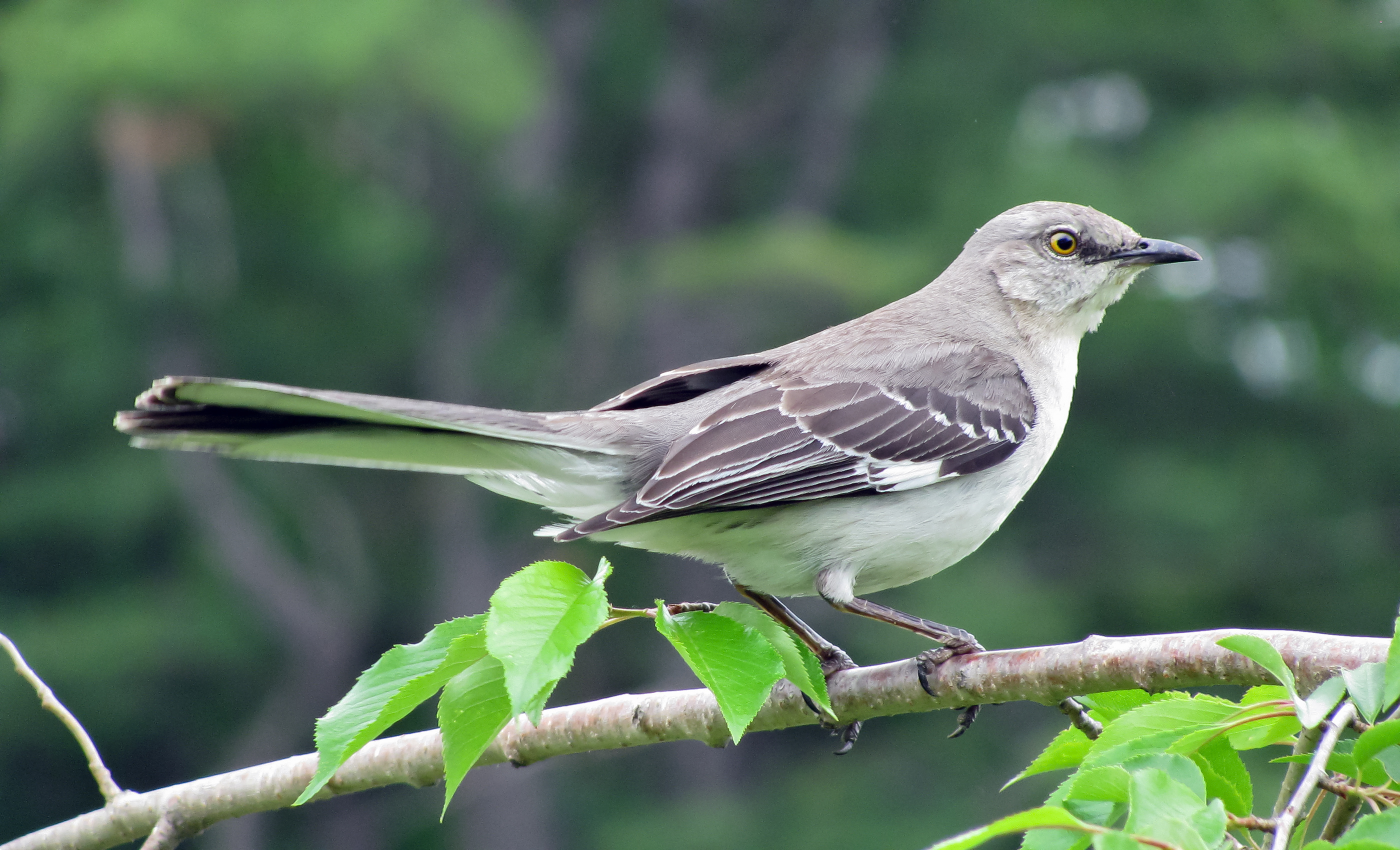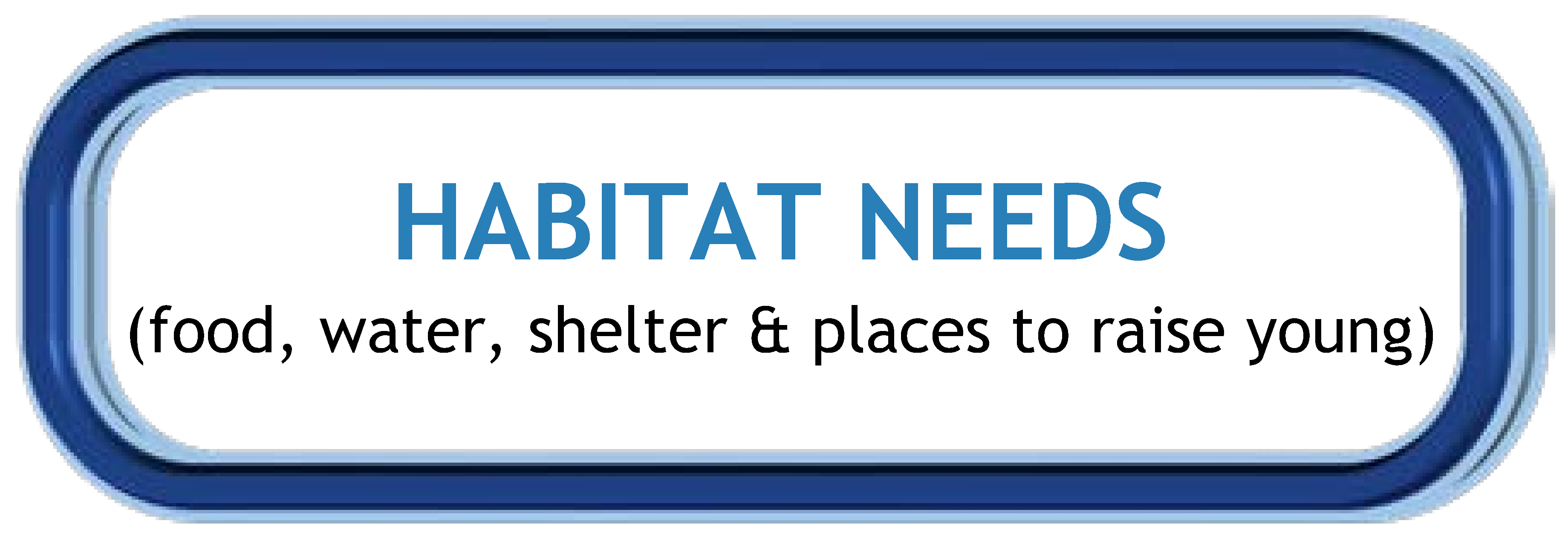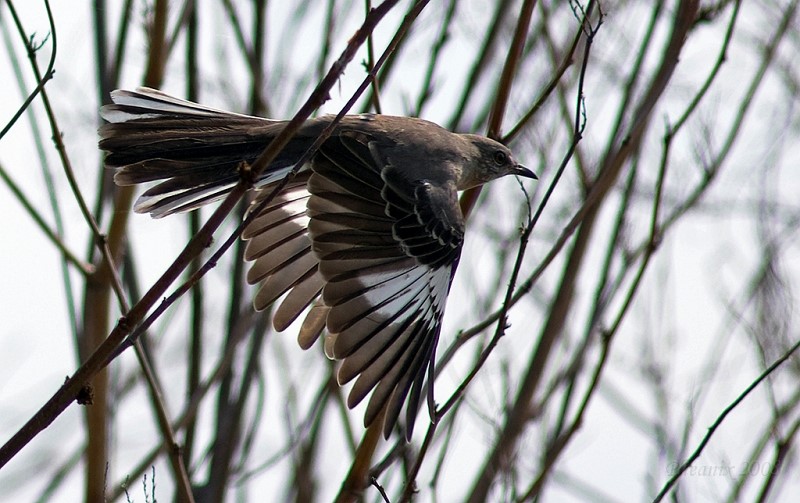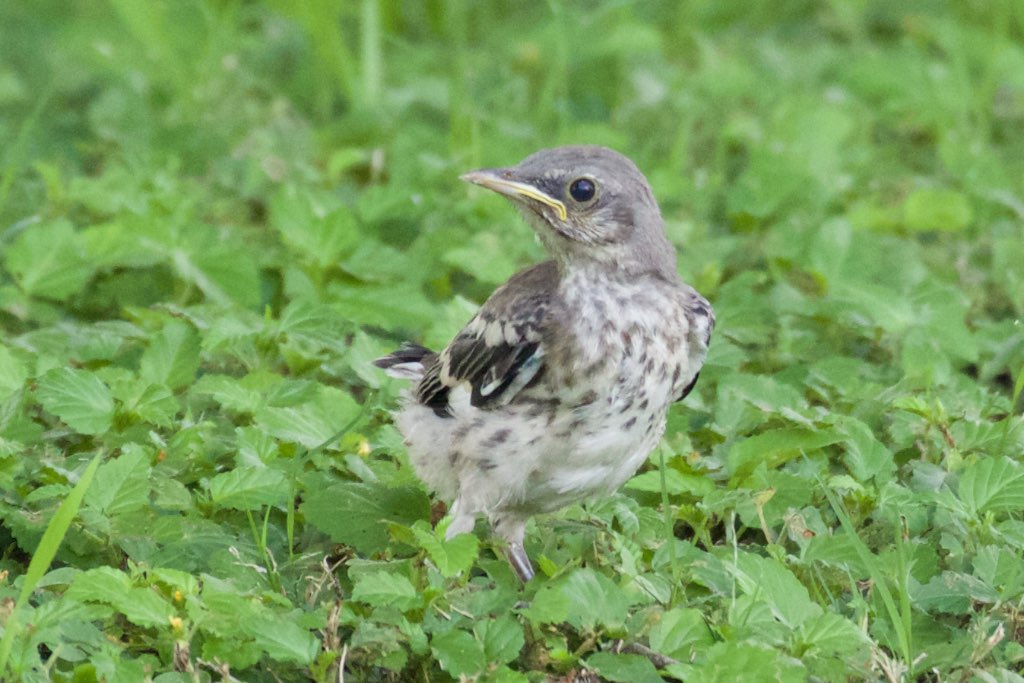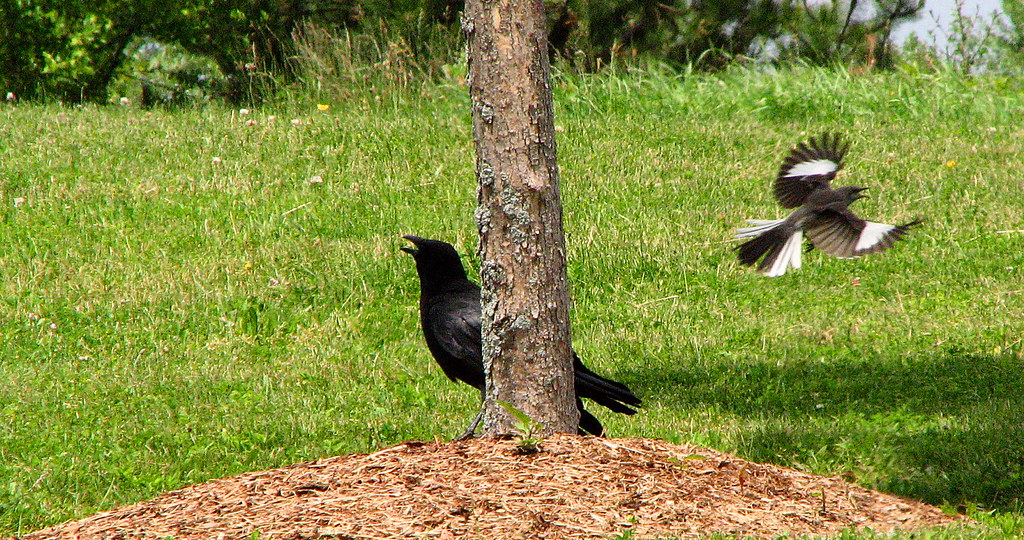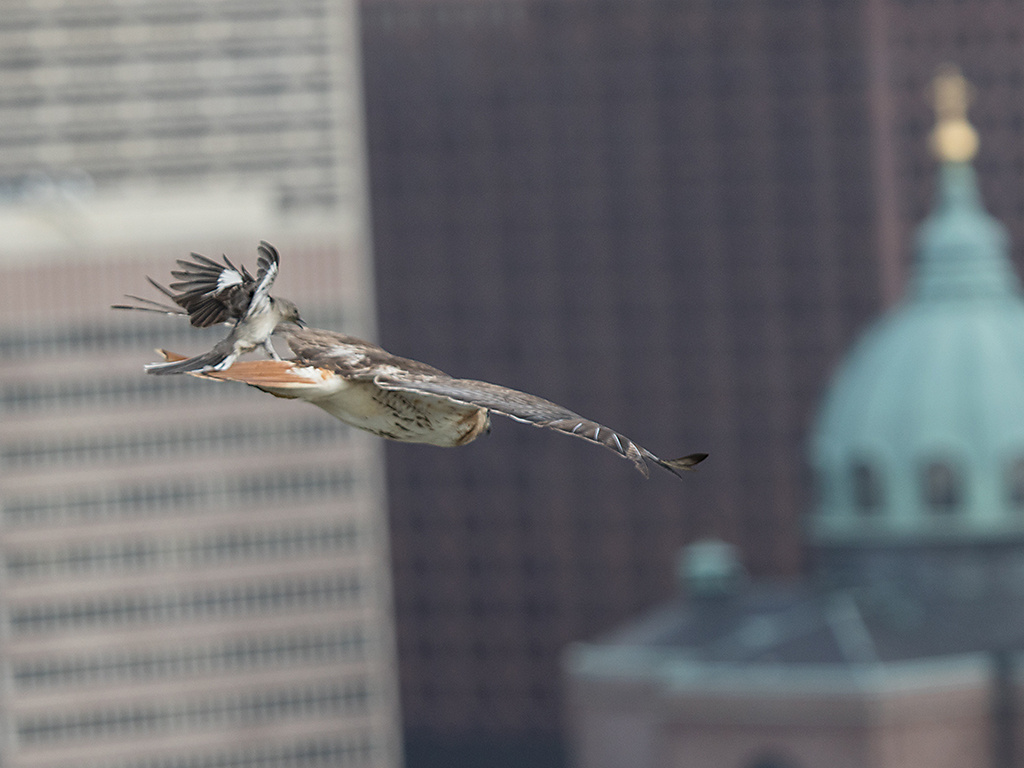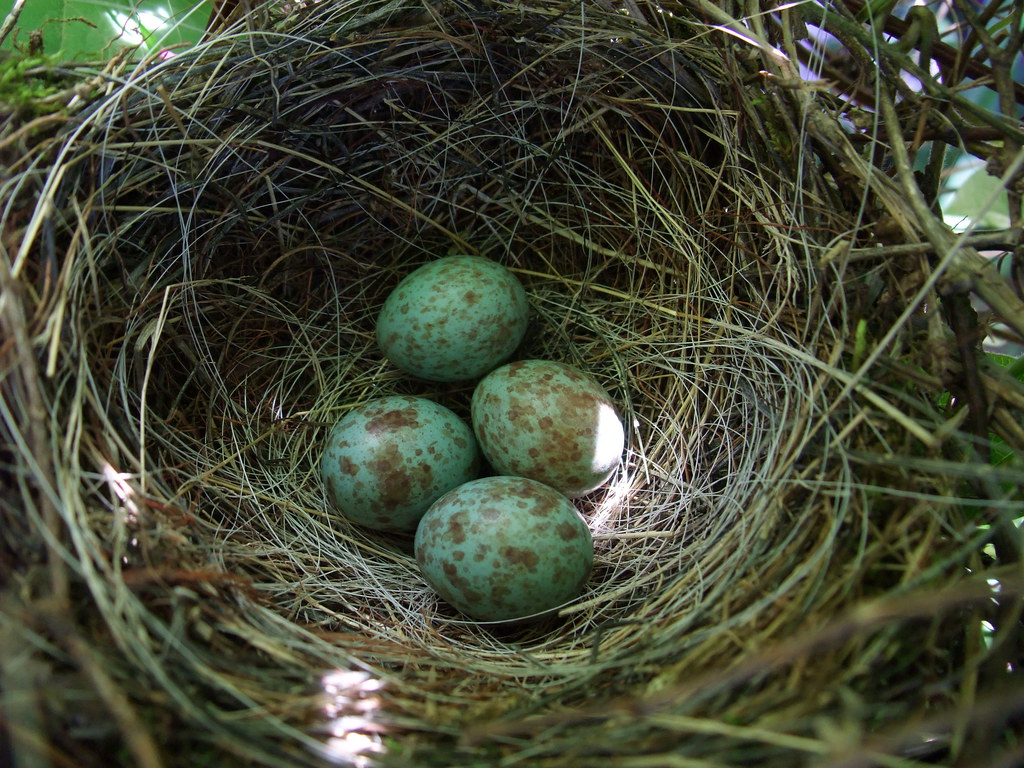Wonders of Wildlife: Northern Mockingbird
Northern Mockingbird
Scientific Name: Mimus polyglottos
Found in Alabama: Statewide
Diet: Omnivore (eats plants and animals) |
|
Northern Mockingbird
Wikimedia - Captain-tucker
Click image to enlarge it |
Learn more about...
| CLASSIFICATION |
| |
- I am a vertebrate (an animal with a spine or backbone).
- I am warm-blooded, so I can control my body temperature.
- I have feathers on the outside of my body that keep me warm.
- I breathe with lungs just like you.
- I have 2 legs.
- I have wings.
|
Scientists use basic traits to group animals into different taxonomic classes.
For a taxonomic classification chart comparing key traits of common backyard wildlife,
CLICK HERE! |
|
| The Mockingbird is a BIRD! |
| IDENTIFICATION TIPS |
| |
|
|
Size: |
- Adults can reach 9 inches in length
- Weigh around 2 ounces
- Wingspan ranges from 12 - 14 inches
|
Northern Mockingbird in Flight, showing white wing bars
Wikimedia - Pheanix
Click on image to enlarge it
|
| |
|
Key
Characteristics: |
- Brownish-gray or pale body
- Iconic white bands on the wings
- Long legs and long tail
- Slightly curved bill
|
| |
|
|
Young: |
- Young have spotting on the chest
- Eyes appear darker than the adults
|
Juvenile Northern Mockingbird
Wikimedia - HarmonyonPlanetEarth
Click on image to enlarge it
|
| ADAPTATIONS |
| |
| PHYSICAL ADAPTATIONS |
| |
| Birds can fly: |
- Birds have feathers on their wings rather than hair like humans. Feathers are light, waterproof, and are adjustable for flight control.
- Birds have lightweight beaks instead of heavy jaws and teeth like humans.
- Most bones in their bodies are hollow or honeycombed, making them very lightweight. Some of their bones are fused for increased efficiency and lighter weight.
- Birds have a larger and more efficient respiratory system than humans do since flight is a physically-demanding activity.
|
| |
| Birds can digest whole prey: |
- Birds do not have teeth and are not able to chew food. Because of this, they have a specialized part of their stomach, called a gizzard, that helps with digestion by grinding food.
- The small stones, sand, and grit that birds pick up while they are eating are stored in the gizzard.
- Once food is swallowed and makes its way to the gizzard, it is pulverized by the grit and stomach muscles.
- Some birds like chickens, ducks, and turkeys have thick, muscular gizzards. Other birds that eat food items that are easy to digest, such as nectar and soft-bodied insects, have thin-walled gizzards.
|
| |
| BEHAVIORAL ADAPTATIONS |
| |
| Mockingbirds are diurnal: |
- They are active during the day (diurnal).
|
| |
| Mockingbirds have incredible singing and mimicking abilities: |
- Mockingbirds use a variety of sounds to communicate with one another.
- They call for many reasons, like warning others of a possible predator or threat and to establish territories.
- Males sing and call more often and more loudly than females.
- The scientific name, Mimus polyglottos, translates to "many-tongued mimic" because they are skilled in imitating the calls of other types of birds as well as other sounds.
- Mockingbirds learn new songs and sounds throughout their whole lives.
- They are very vocal and will sing day and night.
|
| |
| Mockingbirds are territorial: |
- Mockingbirds are known for being territorial around nest sites and feeding areas.
- They may show signs of aggression towards intruders, including humans, using threatening postures and flying towards the intruder.
- If the threat does not back down based on the actions of a single mockingbird, mockingbirds from nearby nest sites may respond to the warning call and join in defending the territory.
|
| |
|
Mockingbird defending its territory
Flickr - Jude
Click on image to enlarge it
|
Mockingbird fighting off hawk in territory
Wikimedia - Chuck Homler d/b/a Focus On Wildlife
Click on image to enlarge it
|
| LIFE CYCLE |
| |
|
|
| Life Cycle Stages of the Northern Mockingbird |
| |
|
|
Nest: |
- Males build cup shaped nest made from dead twigs.
- Nest is lined with grasses, dead leaves, or man made items.
- It is typically placed on low branches in shrubs.
|
Mockingbird Eggs
Flickr - Elizabeth Sellers
Click on image to enlarge it |
| |
|
Eggs: |
- Females lay 2 - 3 hard-shelled eggs per brood.
- Eggs are light blue or greenish white with red or brown blotches.
- Each egg is oval shaped and reaches just over an inch long and 0.8 inch wide.
- They have between 2 -2 broods per year, often overlapping.
|
| |
|
|
Young: |
- Babies hatch from the eggs after 12 - 13 days.
- When they hatch, they have a small amount of soft, gray down feathers.
- They remain in the nest for 12 - 13 days.
- Males are responsible for feeding the young from the first brood while the females are incubating the eggs for the second brood.
|
| |
|
|
Life Span: |
|
| NATURAL Habitat Needs |
ADULTS |
YOUNG |
| Food |
- During warmer summer months, they feed on invertebrates (animals without a spine or backbone) such as earthworms, beetles, ants, crickets, moths, grasshoppers, bees, and wasps.
- In the colder winter months when insects are not as abundant, they feed on fruits, nuts, and seeds.
|
- Parents provide food for the young.
- Upon hatching, they are fed mostly invertebrates (animals without a spine or backbone) including beetles, ants, moths, crickets, and grasshoppers.
- As they grow, the parents will provide them with more fruit mixed in to the diet.
|
| Water |
- They drink from permanent sources of freshwater including rivers, streams, lakes.
- They will also drink from temporary sources of freshwater such as puddles and droplets of raindrops or dew that collect on plants.
- They can obtain hydration from sap from trees that have recently been pruned (cut).
|
- Hydration is obtained from food sources until the young are independent enough to leave the nest and find a source of water.
|
| Shelter |
- They live in short, grassy areas with nearby shrubs and trees.
|
- Nest built by parents with surrounding leaves provides protection.
|
| Places to Raise Young |
- Male builds nests made of twigs, grasses and other materials.
- Nest is placed in low branches within shrubs and trees.
|
|
BACKYARD
Habitat Needs |
ADULTS |
YOUNG |
| Food |
- Plant fruiting trees and bushes such as blackberry, mulberry, and hawthorne to provide fruit sources.
- Do not use herbicides or pesticides that will harm populations of invertebrates.
|
| Water |
- If there is not a freshwater source nearby, provide a bird bath.
|
- Hydration is obtained from food sources until the young are independent enough to leave the nest and find a source of water.
|
| Shelter |
- Provide open, grassy habitats with shrubs and bushes nearby.
|
- Do not trim shrubs and bushes, especially during the spring and summer as parents will abandon nests that have been disturbed.
|
| Places to Raise Young |
- Plant shrubs and bushes where they can build a low-resting nest.
- Do not trim or prune shrubs during the spring and summer when nesting sites are most often used.
|
|
| ECOLOGICAL ROLE |
| |
|
| Animals play an important ecological role in the health of habitats and ecosystems. |
| |
|
|
Food Source:
|
- Adult northern mockingbirds provide a food source for great horned owls, eastern screech owls, and sharp shined hawks.
- The young may be eaten by red-tailed hawks and crows, and the eggs are often eaten by blue jays, snakes, and squirrels.
|
|
Predation by cats is the number one direct, human-caused threats to birds in the U.S. and Canada. In the U.S., as many as 2.4 billion birds are killed by cats each year. To read more about this, CLICK HERE! |
|
| |
|
Insect Control: |
- Northern mockingbirds play a role in controlling the population size of the insect species that they feed on, like beetles, ants, wasps, and grasshoppers.
|
| |
|
| |
|
|
Seed Dispersal: |
- Birds that eat fruits are responsible for spreading the seeds of the plants that they came from.
- Sometimes birds simply carry the seed away from the tree before dropping it.
- More often, after birds eat fruits and berries, they poop them out, covered in a natural fertilizer.
- This helps new plants grow in their new location.
- This form of seed dispersal (moving seeds from one location to another) is an important part of plant reproduction and survival.
|
INFORMATION SOURCES FOR THIS SPECIES
.




 Wildlife Tag
Wildlife Tag
